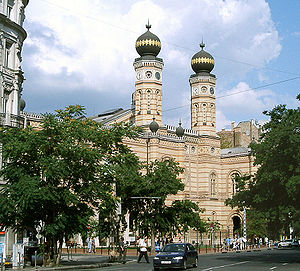
Neolog
Encyclopedia

Neolog Judaism is a mild reform movement within Judaism
Judaism
Judaism ) is the "religion, philosophy, and way of life" of the Jewish people...
, mainly in Hungarian
Hungarian language
Hungarian is a Uralic language, part of the Ugric group. With some 14 million speakers, it is one of the most widely spoken non-Indo-European languages in Europe....
-speaking regions of Europe, which began as a result of the Hungarian Jewish Congress, convened on December 14, 1868. The reforms were comparable to the more traditional wing of U.S. Conservative Judaism
Conservative Judaism
Conservative Judaism is a modern stream of Judaism that arose out of intellectual currents in Germany in the mid-19th century and took institutional form in the United States in the early 1900s.Conservative Judaism has its roots in the school of thought known as Positive-Historical Judaism,...
. At the time of its founding, the Orthodox Jews in these regions were opposed to all modern innovations, so even these modest reforms had led to sharp organizational separation. Communities that aligned with neither the Orthodox nor the Neologs were known as the Status Quo.
In the nineteenth century, the Neolog Jews were located mainly in the cities and larger towns. They arose in the environment of the latter period of the Austro-Hungarian Empire, a generally good period for upwardly mobile Jews, especially those of modernizing inclinations. In the Hungarian portion of the Empire, many Jews (nearly all Neologs and even some of the Orthodox) adopted the Hungarian language
Hungarian language
Hungarian is a Uralic language, part of the Ugric group. With some 14 million speakers, it is one of the most widely spoken non-Indo-European languages in Europe....
, rather than Yiddish, as their primary language and viewed themselves as "Hungarians of Jewish religion".
In the era of Communist Hungary after World War II, the government forced Orthodox and Neolog organizations there into a single organizational structure, albeit with a semi-autonomous Orthodox section. However, all three denominations (Orthodox, Neolog and Status Quo) have resumed their separate existences in the post-Communist period. The secular Jews nowadays, concentrated especially in Budapest, and representing the majority of the relatively small Jewish community of Hungary, are generally better connected to the Neolog institutions, sometimes also to the more Orthodox ones of the Habad hassidim.
Further reading
- Patai, Raphael, The Jews of Hungary: history, Culture, Psychology, Detroit, Michigan, Wayne State University Press, 1996, ISBN 0-8143-2561-0
- Patai, Raphael, Apprentice in Budapest: Memories of a World That Is No More Lanham, Maryland, Lexington Books, 2000, ISBN 0-7391-0210-9

